60th Anniversary of Tristan's 1961 Volcano, Part 2
Issue date: 21st March 2022
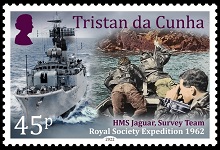 |
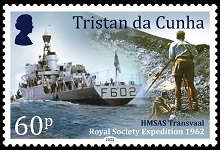 |
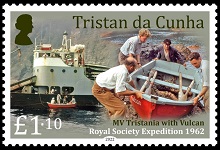 |
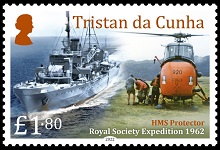 |
| 202201 | Mint Stamps (45p, 60p, £1.10, £1.80) | £3.95 | Shop > |
| 202202 | First Day Cover (with 45p, 60p, £1.10, £1.80 stamps) | £5.15 |
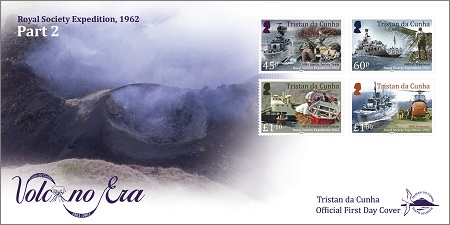
Royal Society Expedition
Arrangements to organise a Royal Society Expedition (RSE) were made very swiftly after the eruption started, as on 14th October 1961, before the islanders arrived in Cape Town, Martin Holdgate wrote to the Colonial Office to suggest a RSE be planned as soon as possible. The RS responded positively and by November a team was organised, led by Dr Ian Gass of Leeds University, and including fellow geologist Dr Roger Le Maitre, who, like Martin, was a member of the 1955-56 Gough Island Scientific Survey and so knew Tristan well. Allan Crawford was chosen to join the expedition as a Tristan expert, and he was able to co-ordinate arrangements for supplies in Cape Town. Two young single islanders, Adam Swain and Joseph Glass were chosen by Chief Willie Repetto to act as local guides, partly to ensure married men could continue to earn money to support their families.
On 16th December 1961 HMS Jaguar brought RSE geologists Roger Le Maitre and Peter Harris to make an initial assessment, but the erupting volcano prevented a landing. The full RSE arrived at Tristan on 27th January from Cape Town aboard the frigate SAS Transvaal. In the meantime, islanders moved from Pendell Camp to Calshot in Hampshire on 23rd January to live in houses vacated by the Air Ministry who operated flying-boats on Southampton Water during World War II. It should be noted that Calshot was regarded at that time to be the new permanent home for island families to settle in the UK unless they wished to move elsewhere in the country.
The team made a detailed survey of the new volcanic eruptive centre, and although they were unable to risk climbing to the main crater until 8th March, their timing was perfect as volcanic activity ceased during the expedition and so a complete study of the new cone was possible. The RSE also made a topographical and geological map of the whole island which remains the most detailed Tristan map ever published. Studies of flora and fauna plotted significant, but limited, damage to plant and animal life along the Settlement Plain and up to the edge of the cliffs above.
The RSE was taken off the island by HMS Protector, using its helicopter, on 20th March, and the team's report was keenly awaited by officials and islanders alike. Adam Swain and Joseph Glass returned to Southampton aboard RMS Windsor Castle on 13th April. They reported that the village had been spared damage and 'There is nothing to stop us going back.' This led to an immediate clamour for the islanders to return home.
A meeting that evening was planned to enable Dr Gass to report the RSE findings, which he carried out, but he had no authority to speculate on the possibility of re-settlement. Islanders, buoyed by the positive reports from Adam and Joseph, and led by a determined Chief Willie Repetto, now, almost as one, chanted 'We want to go back to our island'. The meeting became unruly, Dr Gass and Administrator Peter Wheeler left early, and the entire mood of the refugees had changed in a day. There were many difficulties, twists and turns all described in the book "Nothing Can Stop Us", but it was the RSE which proved the turning point that led to re-settlement of Tristan da Cunha over the next 18 months.
Description of the Stamps
The stamps all show one of the ships associated with the expedition alongside scenes showing various activities that took place during the RSE.
45p - HMS Jaguar is shown together with an image of its motor whaler edging towards the lava flow with Roger Le Maitre and Peter Harris aboard to study the erupting volcano on 17th January 1961. They estimated the lava to be 20m thick at the water's edge and the local sea temperature 27C.
60p - HMSAS Transvaal with a scene showing a survey of the volcano being carried out.
£1.10 - MV Tristania with the dinghy Vulcan moored alongside. Also shown is the Vulcan dinghy being drawn up the beach at the landing site by Garden Gate by Allan Crawford, Jim Dickson, Joseph Glass and Roger Le Maitre. Photograph from Donald Baird.
£1.80 - HMS Protector with its helicopter taking off the RSE team from Tristan on 20th March 1962.
First Day Cover - The First Day Cover illustration shows part of a photograph taken by RSE team member Donald Baird from the cliffs behind the 1961 volcano showing the peripheral crater emitting sulphurous gases.
Technical Specifications from Pobjoy Mint Ltd.
| Photographs: |
45p HMS Jaguar Survey Team - F.C.G.Vesty (Allan Crawford Collection) 60p HMSAS Transvaal Scientist - Allan Crawford £1.10 MV Tristania with Vulcan - Donald Baird £1.80 HMS Protector Helicopter - Allan Crawford FDC Volcano - Donald Baird |
||
| Designer: | Andrew Robinson | Printer: | Cartor |
| Stamp size: | 42 x 28mm | Perforation: | 13¼ x 13½ per 2cms |
| Process: | Lithography | Sheet Layout: | 10 |
| Production Co-ordination: | Creative Direction (Worldwide) Ltd | ||
The Tristan Post Office would like to acknowledge the kind help and assistance of Mike Faulds and Richard Grundy.
